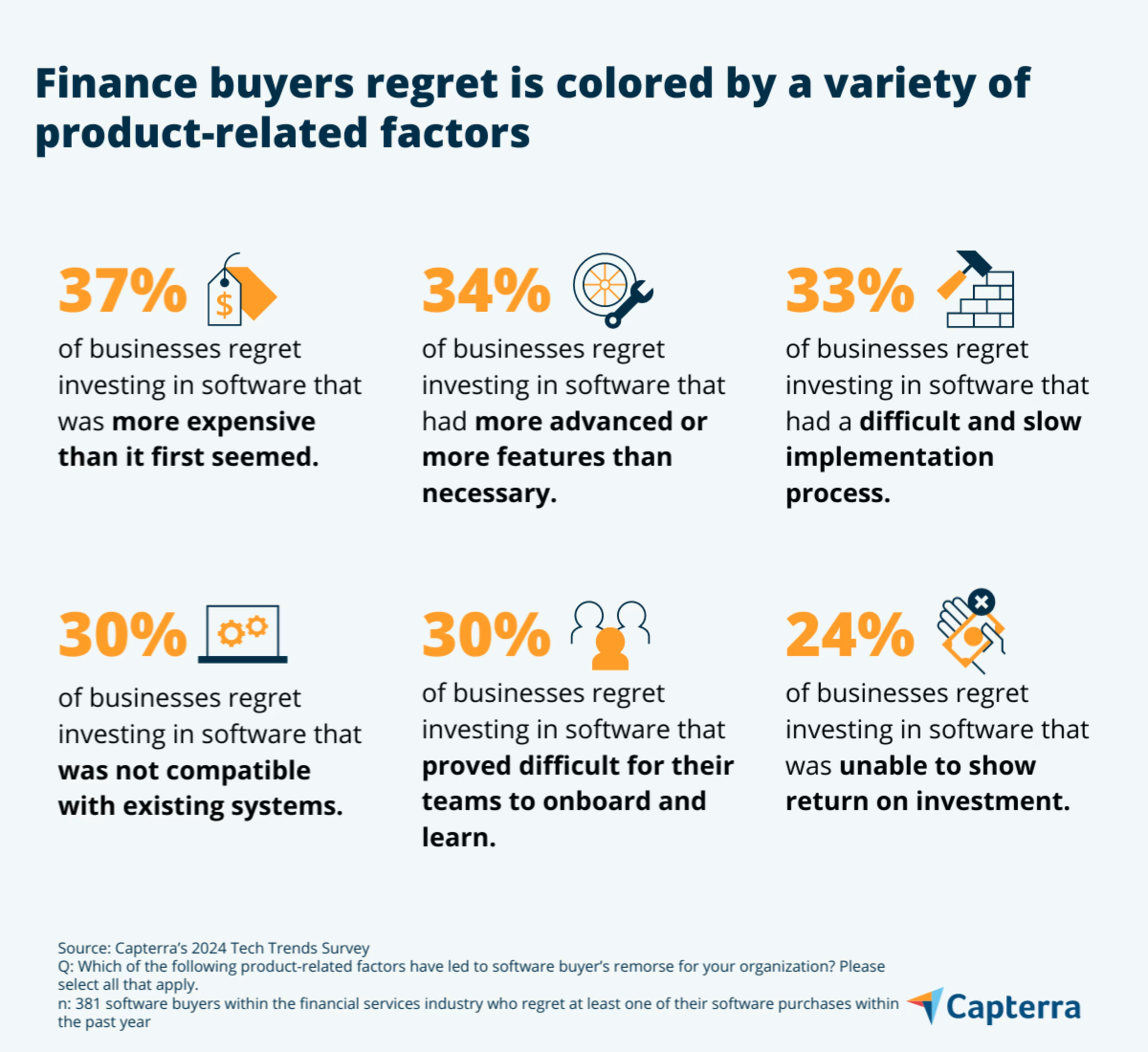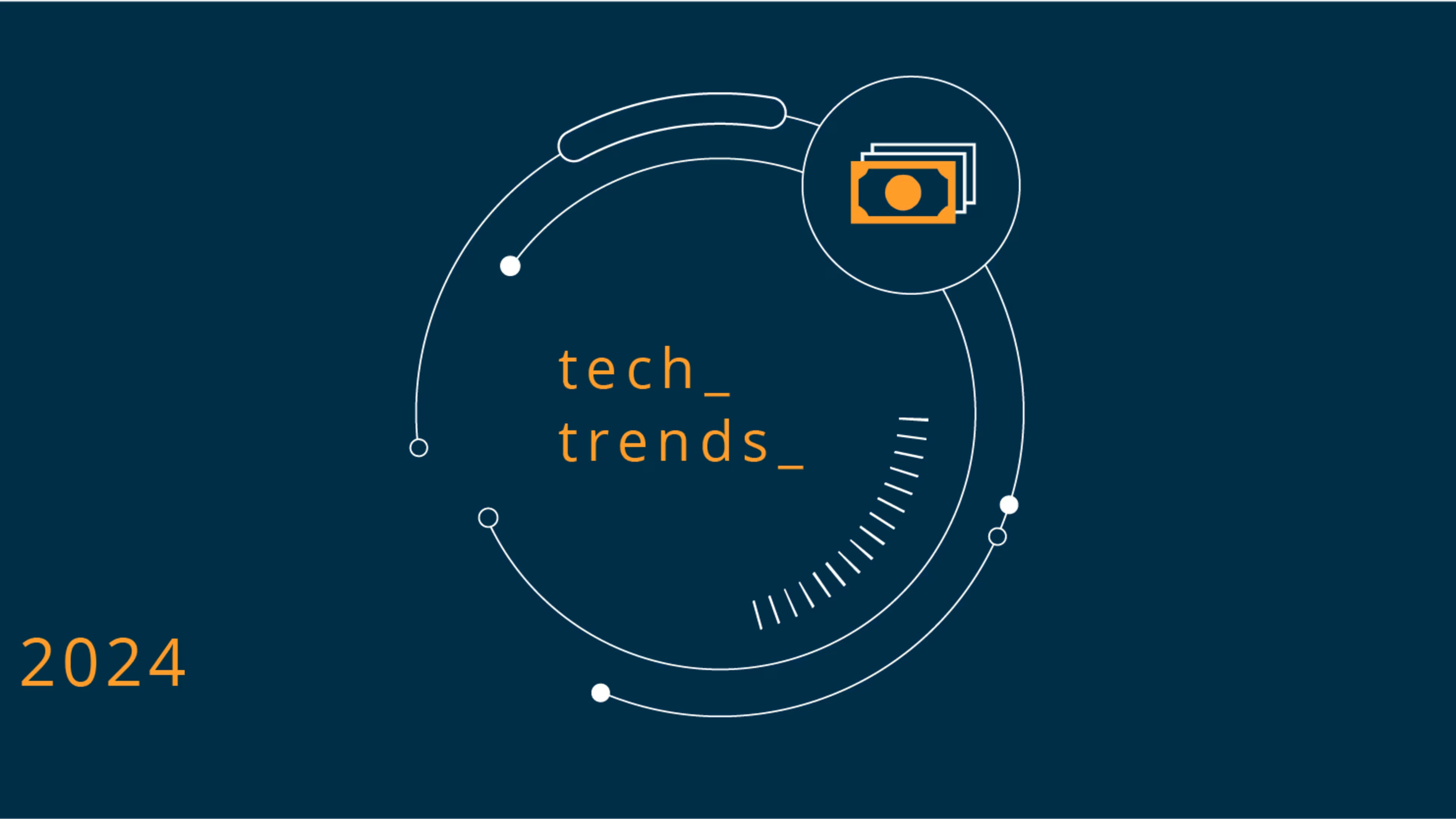70% of finance software buyers regret their purchase—here's how to avoid a bad decision
Looking to the new year, small and midsize businesses (SMBs) continue to face many of the same economic challenges they grappled with in 2023. Interest rates remain high, inflation still plagues the economy, and it’s very likely that a recession is unavoidable. Ensuring that every dollar is well spent is more important than ever, and using financial software to its fullest can help organizations increase efficiencies and save across the board.
According to Capterra’s 2024 Tech Survey, however, 70% of software buyers representing financial organizations across the world regret one or more software purchases within the last year.*
To help your company avoid buyer’s regret, we’ve pulled together major themes based on your peer’s buying strategies and reflections on their own software journey. These insights can ensure that your business feels confident about the technology you adopt and that you’re prepared for what the future has in store.
Key findings
41% of finance buyers say identifying software during the planning phase is a challenge, and a similar number voice concerns about choosing software that meets their security requirements.
72% plan to spend more on software for their business in the coming year than they did in 2023.
70% say that they regret at least one of their software purchases within the past year—that’s 10% more than in other industries.
Security and integration are top challenges for finance software buyers
Managing money and sensitive data is central to the finance industry, and this poses unique challenges when planning new software investments. For this reason, 41% say concerns about security are a top challenge when buying software.
Just as many (41%) say identifying the right software for their operation is a challenge.
Further complicating the selection process is the fact that not only must the software they choose integrate with their internal systems, it must be interoperable with payment processors, banks, and other platforms that form the backbone of the economy. This is likely why more than a third say finding software solutions that are compatible with their existing systems is a top challenge.

Nearly all finance buyers (98%) start the buying process by putting together a list of potential software vendors. Most respondents say that these lists include three to five options, and to create these lists they look at customer reviews, software rankings, or vendor websites.
Sixty-seven percent of respondents say that it took them between three to six months to evaluate and determine which software would be a good fit for their business. This timeframe underscores the danger of choosing the wrong software, as it can waste precious resources and time.
/ Key takeaway
Our research shows that longer software evaluation periods correlate to higher levels of purchase regret. Streamline your software evaluation phase by using sites with verified customer reviews making a concise list of no more than five options, then reaching out to each for hands-on demos. These experiences can help you see if vendor solutions mesh with your systems and also allows you the opportunity to assess the security features of the software you’re considering.
Capterra’s finance software directory is your one-stop shop for software buyers guides, customer reviews, estimated tech pricing, and a wealth of other information your company can use to streamline your tech selection process.
The impact of buyer's regret is significant and influenced primarily by product-related factors
Unfortunately, 70% of finance buyers say that they regret at least one of their software purchases within the past year, and 54% feel that these decisions have had a significant impact on their businesses in the long-term.
Poor software decisions can needlessly drain company coffers, hamper productivity, and even create tension with employees who find themselves stuck using difficult software that makes their job harder than it needs to be.
Some of the glaring signs that buyers had chosen the wrong technology included incompatibility with other systems, and the total investment being more expensive than what they were led to believe.

Respondents dealt with buyer’s regret in a handful of ways, with the top response being to replace the software they purchased with another from a different vendor. Notably, a little over a quarter of buyers stopped communicating with their vendor entirely after feeling software didn’t meet their expectations, and a similar percentage canceled their contract outright after experiencing regret. Surprisingly, only 27% of respondents who experienced buyer’s regret requested a refund.
On the more proactive side of things, 31% of finance buyers say they took the chance to renegotiate the cost of their software contract with their vendor or that they coordinated with them to remedy any issues.
Respondents also identified actions vendors could take to address any pitfalls—a little less than a half say working with a dedicated staff member, having the vendor respond immediately to requests, and enhanced training and implementing assistance would be especially helpful to assuage buyer’s regret.
/ Key takeaway
Strong communication channels between internal stakeholders can prevent your company from many of the product-related challenges respondents report facing. By aligning on selection criteria for software, you can avoid choosing solutions with too many features and iron out ways to make the implementation process smoother. Performing a security audit before tech selection starts can give your company an idea of where its weak spots are, which can inform vendor selection and help outline concrete ways for your investments to show return on investment (ROI).
Most businesses will spend more on software next year; IT security and management are top priorities
With the future in mind, 72% of finance buyers say that they plan to spend more on software in the coming year than they did in 2023.

As they reflect on their budget for next year, finance buyers share that cybersecurity and data protection, customer relationship management, and IT management software will be among some of their top investment priorities. Each of these solutions has a place in ensuring that financial assets are secure and that the systems governing transactions are streamlined and able to meet customers’ needs.
Respondents will also be investing further in accounting and finance (34%), marketing (26%), and business intelligence software (25%). Many companies are using these solutions to navigate current financial trends, as they provide them with a vast array of benefits:
Accounting & finance software: There’s been an exodus of accountants and auditors over the past two years and many businesses have turned to accounting software to save money, free up time, and deal with the vacuum of talent left by the ongoing accounting shortage—39% of financial buyers already use some form of this tech, which can automate bookkeeping, help devise budgets, manage payroll, and more.
Marketing software: A third of respondents share that their organization uses marketing software, which aids them in creating content in a variety of mediums all with the goal of showcasing the talents and services financial professionals provide. Nowadays, many consumers are increasingly flocking to financial technology —also known as fintech—rather than consulting a financial professional for help. By leveraging marketing solutions, financial professionals can reorient themselves as clients’ primary source of advice and analysis, underscoring their specialized knowledge and expertise which fintech fails to match up to.
Business intelligence software: From inflation to a volatile commercial real estate market, businesses have had to deal with a variety of expected—and unexpected—economic events that have drastically impacted the financial well-being of their organization. A little less than a third report that their organization already has the business intelligence software to navigate these economic hurdles, which allows them to leverage historic data to make predictions about market trends and adjust their financial strategies accordingly.
/ Key takeaway
Understanding the unique needs of your business can help you avoid buyer’s regret. Almost every financial institution will need strong cybersecurity software, but marketing software might not be useful for everyone. This doesn’t mean you shouldn’t stay up-to-date on industry trends or let them inform your decisions, but by carefully aligning your investments with your organization’s long-term goals, you can ensure the software you leverage addresses any operational gaps or pain points you might have.
70% of finance buyers experience regret—that’s 10% higher than other industries
We’ve already covered a few ways to avoid buyer’s regret, but it never hurts to have more information at your disposal. Here are a few tips that you should keep in mind during your software selection process.
1. Don't go it alone
Selecting the right software should be a team effort—however, 45% of finance buyers say that they’re solely responsible for purchasing software for their company. You're more likely to avoid buyer’s regret if you include day-to-day users, other organizational leaders, and your IT team. If these internal resources aren’t available, you can always work with an industry expert. Accounting firms and financial consultants can help you identify the right solutions and keep you informed on industry trends that will shape 2024.
2. Establish a budget and factor in all costs
When considering the cost of new software, don’t forget that the total cost will include more than just subscription payments. Your budget should include licensing fees, implementation services, onboarding and training costs, and fees that additional features might incur. Also note that time and manpower will be devoted to integrating new software. Not only will this broadened perspective let your business allocate resources more efficiently, it will provide a framework for questions you can ask vendors as you discuss costs or demo products.
3. Scrutinize support and training services
In a perfect world, implementing new software would be a seamless experience. Unfortunately, your company is bound to encounter bumps in the road during and after implementation. Strong customer support and training options can help your staff understand how to use software and how to get the right assistance in case trouble arises. Make sure the vendor that you partner with offers training resources, user guides, and dedicated or quickly accessible customer support. A simple and effective way to scrutinize these processes—beyond talking with your vendor—is to ask other businesses about their experiences with onboarding and ongoing vendor support.
Solid software selection is crucial to success in 2024
Bringing in new tools and technology will always be a pivotal part of financial institutions’ success. Avoiding buyer’s regret is a priority, and your company can take advantage of the initial stages of scouting software to leverage product trials or demonstrations to ensure the software you select is secure and compatible with your systems.
While industry trends will always be a factor, make sure to align your software needs with specific business goals. And, if you’re struggling with buyer’s regret from past software decisions, don’t hesitate to restructure your internal communication channels so that stakeholders can easily coordinate and find ways to bypass product-related challenges in the future.
Taking a tactical and holistic approach to your software journey will enable you to move into the new year with confidence, ready to tackle whatever 2024 has in store for your business.
Here are some additional resources to get you headed in the right direction:
How To Communicate With Software Vendors During the Purchase Process
5 Things Buyers Wish They’d Known Before The Software Buying Process
Capterra’s 2024 SMB Tech Trends Annual State of Software Adoption Reports capture global trends across industries and reveal how small to midsize business leaders are adopting technologies to embrace change, optimize efficiency, and accelerate growth. Our reports are designed to support decision-makers with the insights they need to embrace the right technology and services.
2024 U.S. Tech Trends Report: 58% of Businesses Regret a Recent Software Purchase
Capterra's 2024 Tech Trends Report: An In-Depth Look at Software Purchase Regret (e-book)
Capterra’s 2024 Tech Trends Report: Insights From Marketers To Watch
Capterra’s 2024 Tech Trends Report: How Retailers Can Avoid Regrettable Software Purchases

